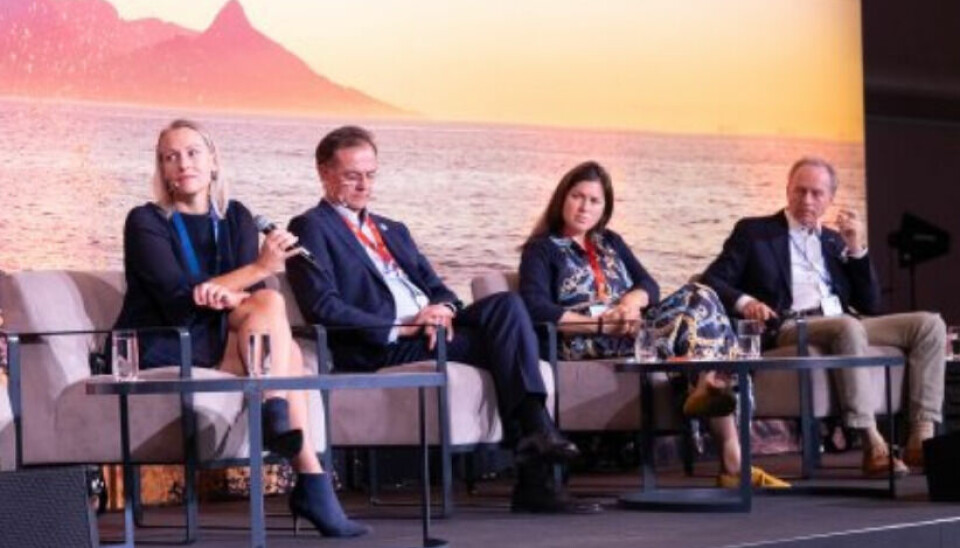
Salmon feed firm’s marketing chief calls for more fisheries certification
Marine ingredients sector has a long way to go, says BioMar's Bryar
Salmon feed producer BioMar’s global marketing director Katherine Bryar has called for more Fishery Improvement Projects (FIP) in the developing world, especially Africa and Asia, to increase access to responsibly sourced marine ingredients.
Bryar, speaking on the first day of the annual conference of marine ingredients organisation IFFO, said BioMar accepts only certified marine ingredients because that’s what fish farmers and retailers are asking for, but with only 50% certified globally, the marine ingredients industry has still got a long way to go.
“Along with certification, we also need verification, using data software to verify source. Step one is certification, and it is spreading across all markets,” IFFO reported Bryar saying during a panel discussion at the conference in Cape Town, South Africa.
Diversified sourcing
Bryar said that with the scarcity of marine ingredients, the company has diversified the sources of the nutrients it sources. In order to avoid increasing capture and meet the growing demand from aquaculture, marine ingredient inclusion needs to reduce. “If it was possible, the farmers of carnivorous fish would just use marine ingredients, but this isn’t possible, so we need to adapt. Consumers believe that the oceans are overfished,” said Bryar.
Manuel Barange, assistant director general of the United Nations Food and Agriculture Organisation (FAO) and director of its Fisheries and Aquaculture Division, pointed to figures showing that two out of three fisheries are not overfished.
“The most valuable fisheries, with a larger volume of production, tend to be well managed, and this is because the investment to improve management is worth it,” said Barange. “There will always be a bad story, we need to celebrate success and help those who fall behind, which tend to be those that are of lower value.”
Terrific trimmings
Egil Magne Haugstad, chief executive of Pelagia, a leading producer of pelagic fish products, said the marine ingredients industry had contributed fantastically “to the sustainable use of resources that principally humans do not eat, including trimmings which enable other usage of this fantastic material”.
“These unique fantastic ingredients have a huge potential for different markets; even fishmeal is not just protein. IFFO is continuously working for the industry to be more sustainable and encouraging those regions who are trying to be more sustainable to keep improving,” added Haugstad.
Earlier, the conference heard that in the last decade the consumption of aquatic foods has grown at twice the rate of population growth, thus making net contributions to the nutrition of the human population. This growth has been possible thanks to aquaculture, the fastest growing food production industry in the last 50 years, bringing per capita consumption of aquatic foods (excluding algae) to 20.5 kg/year.
African explosion
David Pilling, Africa editor of the Financial Times, explained that by 2030 the population in Africa will double from 1 billion people in 2013 to 2 billion, whereas the populations of the Americas and Europe will remain at 1 billion each. By 2050, one out of four of the world’s population will be African.
Barange highlighted FAO’s estimates that production of aquatic foods over the 2020s will not be sufficient to compensate for population growth in Africa, and as a result, per capita consumption of aquatic foods may decline.
“FAO has developed a Blue Transformation strategy to address this growing problem, promoting sustainable aquaculture growth, ensuring all fisheries are placed under effective management and developing the value chains of aquatic foods,” he said.
The target is to achieve 35% growth in global aquaculture by 2030 with quality foods that are produced sustainably. 100% of marine and inland fisheries should be placed under effective management to produce Maximum Sustainable Yields. The last objective is to upgrade value chains to ensure the social, economic, and environmental viability of aquatic food systems; with the target of increasing and more inclusive returns from aquatic foods, by halving loss and waste, more transparency and traceability, better market access, and more consumer awareness.
An unmanaged fishery
“It is not just focusing on growth; fisheries need to be managed and an example where this is not being done is in West Africa. The public and society will judge the industry and we need to ensure that the fisheries in this area are sustainably managed,” said Barange.
Land in Africa is not an issue so there is huge potential for aquaculture, but it needs to be efficient and dynamic. Marine ingredients should be used in a targeted way, such as in broodstock and hatcheries, said the FAO executive.
Pilling recommended that focus in Africa should be on reducing exports, and building aquaculture systems to create jobs, value, and nutrition.






















































